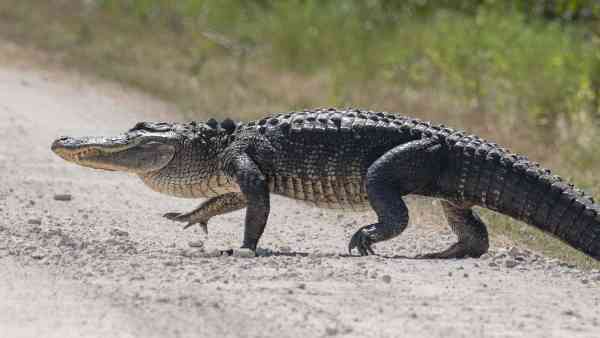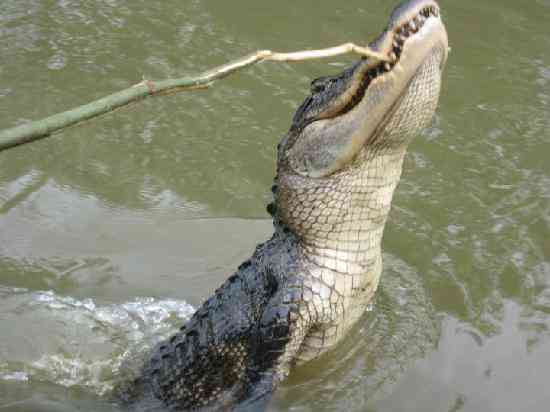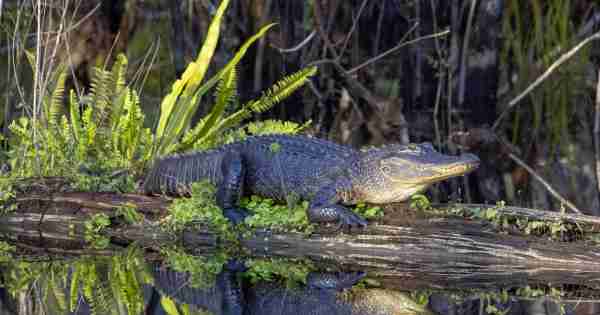Alligators may not be the first creatures that come to mind when thinking about the importance of the ecosystem, but these formidable reptiles play a vital role in maintaining the balance of their habitats. Researchers and conservationists have determined that studying alligator poop, or scat, can provide key insights into their diet, health, and population.
Table of Contents
Scat analysis can identify the specific prey that alligators are consuming, as well as uncovering parasites and bacteria that may affect their health. Furthermore, monitoring population trends through scat analysis is an important tool for protecting alligator populations and the environment that they call home. The next time you see a pile of alligator poop, don’t be repelled. Instead, recognize it as a valuable resource for conservation efforts.
Explanation Of Alligator Poop And Its Significance

Alligator excrement, commonly known as alligator poop, is the feces produced by alligators. It contains undigested food items such as bones, shells, and hair, along with other materials that do not break down in the alligator’s digestive system.
Analyzing the composition of alligator scat can provide valuable information about the alligator’s diet and preferred prey species, shedding light on its impact on the ecosystem. Researchers can gain insights into the alligator’s health by checking for parasites or diseases in the waste, which can offer clues about the overall health of the alligator population.
Furthermore, changes in the composition of alligator scat over time can indicate shifts in the alligator’s diet or habitat. Surprisingly, alligators are not exclusively meat-eaters; they also consume fruits.
Scat analysis plays a crucial role in understanding the alligator population. By monitoring the number of scat samples found in a specific area over time, researchers can assess changes in the alligator population size.
Alligator poop serves as more than just waste material; it is a valuable tool for researchers and conservationists to study these creatures and the environment they inhabit. Understanding the significance of alligator scat can aid in conservation efforts and contribute to the protection and preservation of these fascinating creatures and their ecosystem.
Composition Of Alligator Poop
Alligator poop is not your average scat. It’s a unique mixture of plant matter, animal debris, and pebbles that the alligator has consumed. As opportunistic feeders, these reptiles aren’t too picky when it comes to their diets. Their faeces might contain bits of leaves and stems, as well as chunks of fish, birds, and other small mammals. You might also find tiny stones and sand particles, which the alligator may have swallowed while hunting. All of this might sound a little gross, but it’s interesting to see how resilient and adaptable these creatures are.
What Alligator Poop Can Tell Us About Diet and Health
The excrement of alligators holds valuable insights into their dietary preferences and overall well-being. By scrutinising the contents of an alligator’s faeces, scientists can glean significant information about their eating habits and health condition.
For instance, if an alligator’s scat contains a substantial amount of fish bones, it indicates that the alligator has been primarily consuming fish. This insight provides valuable knowledge about the alligator’s preferred diet and hunting patterns.
Similarly, the presence of numerous feathers in the scat suggests that the alligator has been preying on birds. By analysing the specific types of feathers found, scientists can even pinpoint the particular species of birds that the alligator has been consuming.
Beyond dietary clues, alligator excrement can reveal potential health concerns. If the scat contains a significant number of worm eggs, it may indicate that the alligator is suffering from a parasitic infection. Additionally, a runny or bloody appearance of the scat might be indicative of health issues affecting the alligator.
Hence, studying alligator poop can yield a wealth of information regarding their diet and well-being, providing valuable insights into the lives of these captivating creatures.
What Does The Alligator Poop Look Like?
Alligator poop may not be the most glamorous topic, but it is certainly interesting. The scat looks incredibly long and cylindrical, with a diameter of around 2-3 inches. It can be dark brown or black and has a strong, musky odour. What’s really fascinating is that the contents of alligator poop depend on their diet – fish bones, feathers, shells, and plants are all commonly found. It’s not hard to find alligator poop either, as it’s usually located near water sources like lakes, rivers, and swamps where alligators tend to live.
How Does Alligator Poop?
The digestive process in alligators involves the passage of undigested food, bacteria, and debris through their digestive system. After the alligator swallows food, it moves through the stomach and small intestine, where enzymes and acids break it down. The partially digested food then enters the large intestine, where water and electrolytes are absorbed, and the remaining material is compacted into faeces. These faeces are eventually eliminated through the rectum and anus.
Alligators possess a relatively straightforward digestive system. The composition of their faeces depends on their diet, typically consisting of undigested food particles like fish scales, feathers, shells, and other debris, including plant material.
As aquatic creatures, alligators tend to deposit their faeces in or near water, reflecting their close association with aquatic habitats. In summary, the process of defecation in alligators is similar to that of most other animals: they consume food, undergo a digestive process, and eventually expel the waste near or in the water.
Do Alligators Pee?
Indeed, alligators, like most animals, do urinate as part of their excretory process, along with defecation. In reptiles, including alligators, the urinary and digestive systems are combined into a single organ known as the cloaca, situated near the base of the tail. Consequently, alligators excrete both urine and faeces through the same opening, making it challenging to distinguish between the two.
The frequency of alligator urination can vary based on several factors, such as their diet and overall health. Alligators may urinate anywhere from once a day to once a week.
However, it is essential to emphasise that observing an alligator’s urination habits in the wild is not recommended. Interfering with wildlife is illegal and poses risks to both the observer and the animal. It’s crucial to maintain a safe distance from wild animals and respect their natural behaviours and habitats. If there are any research or conservation efforts involving alligators, they should be conducted responsibly and with appropriate permits or supervision.
Does Alligator Poop Smell?
Alligators may be fascinating creatures, but their faeces can have quite the pungent odour. The strong and musky smell is due to a combination of undigested food particles and bacteria in the faeces. In addition, chemicals such as skatole, indole, and cadaverine produced by the bacteria further intensify the smell. Even when the faeces are dry, the odour can be noticeable. It doesn’t end there either. Alligator poop also contains a high level of methane, contributing to its distinct smell.
Is Alligator Poop Harmful?
Alligator droppings, much like the excrement of most animals, pose no immediate threat if dealt with appropriately. However, it’s crucial to be mindful that alligator faeces can carry dangerous pathogens such as Salmonella, E. coli, and Leptospira, as well as parasites like tapeworms. These microorganisms can cause illnesses in both animals and humans if there’s contact with the faeces.
To ensure your safety, it’s advisable to refrain from direct handling of alligator faeces and to thoroughly wash your hands after coming into contact with it or being in areas where it may be present. Additionally, it’s best to avoid eating or drinking in close proximity to alligator droppings and to sanitise any surfaces that might have been exposed to the faeces.

Furthermore, it’s important to note that alligator faeces can have a negative impact on aquatic life and water sources due to its toxicity. Therefore, it’s essential not to dispose of it in or near bodies of water.
Even though alligator faeces itself is not inherently dangerous, it has the potential to carry harmful bacteria and parasites. As a result, exercising caution while handling it and avoiding direct contact, especially with your hands and mouth, is of utmost importance. Also, take care when disposing of it, making sure not to do so near water sources to prevent contamination.
How Often Does An Alligator Poop?
Alligators, being reptiles, have a slower metabolism compared to mammals, resulting in less frequent defecation. The frequency of alligator defecation can vary based on different factors, including their diet and overall health. They may defecate anywhere from once a day to once a week.
When alligators consume a substantial meal, they may defecate more often as the digestion process takes longer. Conversely, if an alligator is unwell or not eating enough, it may defecate less frequently.
It’s essential to understand that observing an alligator’s defecation habits in the wild is not recommended. Interfering with wildlife is illegal and poses risks to both the observer and the animal involved. Therefore, it’s best to leave alligators and other wild animals undisturbed and observe them from a safe distance to ensure their well-being and your own safety.
What Is The Difference In Between Alligator Poop And Crocodile Poop?
Alligator and crocodile faeces, also referred to as scat, may share some similarities in appearance, but there are distinct differences between the two.
- Diet: Alligators primarily consume fish and reptiles, while crocodiles have a more varied diet, including a significant portion of mammals. Consequently, their scat will reflect the differences in their diets. Alligator scat is more likely to contain fish scales and bones, while crocodile scat may contain more hair and bones from larger mammals.
- Size: Crocodiles are generally larger than alligators, and as a result, their faeces tend to be more substantial in size compared to alligator scat.
- Shape: Alligator faeces typically have a cylindrical shape, while crocodile faeces may exhibit a more curved or spiral form.
- Habitat: Alligators predominantly inhabit freshwater environments like swamps and marshes, whereas crocodiles can be found in both freshwater and saltwater habitats, including rivers and coastal areas. The differences in their habitats can also influence the composition of their faeces.
It’s crucial to emphasise that observing, touching, or smelling alligator or crocodile faeces is not recommended due to the potential presence of harmful bacteria. Both species can carry dangerous pathogens, making it essential to maintain a safe distance from these animals and their waste to ensure personal safety and the well-being of the wildlife.

Methods Of Collecting And Analyzing Alligator Poop
Scientists employ various methods to collect and analyse alligator faeces, each offering unique insights into the animals and their ecosystem:
- Field Observation: Researchers venture into the wild, walking along the shores of lakes or rivers or exploring areas known to be inhabited by alligators. They visually identify and collect alligator scat using gloves or a plastic bag.
- Camera Traps: Cameras are set up near alligator habitats to automatically monitor the animals. These cameras can capture images or videos of alligators and their scat, providing valuable data without direct human intervention.
- Scat Traps: Traps can be strategically placed to collect alligator scat as the animals move through them. This method ensures a controlled and consistent collection of faeces.
Once the scat is collected, scientists can conduct various analyses to gather information about alligator diet and health:
- Visual Inspection: Researchers examine the scat to identify its contents, such as fish bones, feathers, or plant material. This simple observation can offer initial insights into the alligator’s diet.
- Microscopic Examination: Advanced lab equipment, like microscopes, allows scientists to delve deeper into the scat’s composition. For instance, they can look for worm eggs, which might indicate the presence of parasitic infections.
- DNA Analysis: Through DNA testing, scientists can identify specific species of animals or plants present in the scat, providing detailed information about the alligator’s diet and the overall biodiversity of its environment.
By combining these various methods, scientists can gain a comprehensive understanding of alligator behaviour, diet, and health, contributing to broader conservation efforts and ecological research.
The Role Of Alligators In The Ecosystem
Absolutely, alligators are indeed crucial to their ecosystem, playing a significant role in maintaining ecological balance and biodiversity. As apex predators, they occupy the top of the food chain, regulating the populations of various animal species. This control is vital for preventing overpopulation of certain species, which could lead to imbalances in the ecosystem.
One of the valuable roles alligators play is controlling the populations of invasive species like Burmese pythons. By preying on these invasive snakes, alligators help protect native animals from being negatively affected and potentially threatened by the invasive species.
Furthermore, alligators actively shape their environment by creating and maintaining wetlands, marshes, and other aquatic habitats. Their digging and maintenance of canals, ditches, and ponds provide ideal conditions for a diverse range of animals and plants to thrive. These habitats offer breeding grounds, shelter, and food sources for various species, contributing to the overall health and stability of the ecosystem.
The presence of alligators can also serve as an indicator of ecosystem health. As they are sensitive to changes in their environment, any disturbances or threats to their populations could signal underlying issues affecting the broader ecosystem. Monitoring the health and population status of alligators can, therefore, offer insights into the overall well-being of the ecosystem.
Importance Of Alligators In Maintaining Balance In The Ecosystem
One of their most significant contributions is creating and maintaining wetlands and marshes by digging and maintaining canals, ditches, and ponds. These habitats provide homes for various animals and plants, creating a diverse ecosystem that supports many different species. Additionally, alligators are an indicator species, meaning their presence or absence can indicate the overall health of an ecosystem. If alligators are healthy, the rest of the ecosystem is likely healthy too. However, if they are not, it could signal a problem that needs attention.

How Poop Analysis Can Aid In Conservation Efforts
The analysis of alligator faeces holds significant importance in conservation endeavours. Researchers study the dietary patterns of alligators, including their consumption of specific fish or birds. This data becomes instrumental in safeguarding these prey species and ensuring an adequate food supply for alligators.
Similarly, if scientists detect the presence of a particular parasite in alligators’ scat, it offers valuable insights for controlling its spread and safeguarding other ecosystem inhabitants from harm.
Beyond this, alligator scat analysis provides valuable information about their habitats and behaviour. By identifying the plant and animal remains in the faeces, scientists gain a deeper understanding of alligators’ dwellings, eating habits, and movement patterns.
Moreover, this analysis assists in comprehending the impact of human activities on alligators and their environment. Noticeable changes in the alligators’ diet or an increase in parasite presence could indicate pollution or disturbances caused by human actions.
In essence, alligator scat analysis serves as a crucial conservation tool, providing valuable information about alligators’ diets, health, habitats, and the influence of human activities on their well-being. By utilising this knowledge, conservationists can work towards safeguarding these captivating creatures and preserving their natural surroundings.
FAQs
What do alligator droppings look like?
Typically, they are cylindrical in shape and can range between 4 to 10 inches in length. The consistency may vary between wet and dry depending on the water content of their diet. The colour can vary from brown to greenish-brown and will often contain small bits of bone or fur from their prey.
Do alligators excrete?
The answer is yes. Like all living animals, alligators produce waste products that need to be eliminated from their bodies regularly. These reptiles release faeces and urine from their cloacas, which are openings on their underside that serve as both digestive and reproductive outlets.
Do alligators have teeth?
Yes, alligators do have teeth. But these are not just any teeth. Alligators have between 74 to 80 teeth in their jaws at any given time. These teeth are not fixed into their jaw like human teeth, rather they are continually replaced throughout their lifetime.
Final Words
Alligator poop may not be the most glamorous topic of discussion, but it is undeniably valuable for understanding these fascinating creatures and their environment. Scientists can learn a great deal by analysing alligator scat, from examining their diet and health to understanding their habitat and behaviour.
This information can be used to help protect and conserve alligators, an important part of many ecosystems. By identifying the plants and animals found in alligator scat, scientists can gain important insights into the food chain and the health of the ecosystem as a whole. Additionally, analysing the impact of human activities on alligators and their habitat can help guide conservation efforts.
Reference:
- https://pubmed.ncbi.nlm.nih.gov/6496695/
- https://tpwd.texas.gov/publications/pwdpubs/media/pwd_lf_w7000_0488.pdf
- https://dailyutahchronicle.com/2008/02/15/study-shows-how-alligators-digest-heavy-bones/

Jeevan Kodiyan
An animal enthusiast with an interest in zoology, studying the behavior and activities of animals in the wild habitat. I work on research projects related to species conservation and endangered species protection. I also leverage zoology to become an educator, educating others about the importance of protecting our natural environment and the beauty of animals in their natural habitats.









